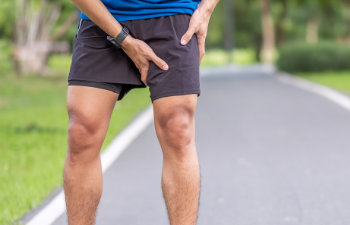How Can I Prevent a Groin Strain This Spring?

Spring is just around the corner, and with the warmer weather and longer days comes the opportunity to get outside and enjoy a variety of activities. However, with increased activity often comes an increased risk of injury. One common injury that can occur during springtime activities is a groin strain. A groin strain can be painful and limit your ability to participate in the activities you enjoy.
The pain management doctors at Allied Pain & Spine Institute offer some recommendations to prevent a groin strain from happening.
What is a Groin Strain?
A groin strain, also known as a groin pull, occurs when the muscles in the groin area are overstretched or torn. The groin area is located on either side of the body where the abdomen meets the thigh, and it is made up of several muscles that work together to move the leg. A groin strain can range in severity from mild discomfort to a complete tear.
Groin strains can be caused by a variety of activities that involve sudden changes in direction or intense movements of the legs. Some common causes of groin strains include:
- Sports activities that involve running, jumping, and sudden changes in direction, such as soccer, basketball and football
- Activities that require kicking, such as martial arts or dance
- Overuse of the groin muscles, such as cycling or long-distance running
- Poor flexibility or muscle imbalances in the hip and thigh muscles
How Can You Prevent a Groin Strain?
Preventing a groin strain involves taking steps to reduce your risk of injury. Here are some tips to help you prevent a groin strain this spring:
Warm-up and Cool-down
Before any physical activity, it’s important to warm up your muscles to prepare them for the upcoming activity. A proper warm-up should include light aerobic exercises, such as jogging or jumping jacks, as well as dynamic stretching exercises to loosen up the muscles. After your activity, it’s important to cool down with some light stretching exercises to help your muscles recover.
Strengthen your Groin Muscles
Strengthening your groin muscles can help prevent strains by improving the flexibility and stability of the muscles. Some exercises that can help strengthen the groin muscles include:
- Hip adductor exercises, such as side-lying leg lifts or seated leg presses
- Hip abductor exercises, such as standing leg lifts or side-lying leg raises
- Squats and lunges to strengthen the leg muscles
Stretching regularly can help improve your flexibility and reduce your risk of a groin strain.
Gradually Increase Activity Level
Gradually increasing your activity level after a long, inactive winter season can help prevent overuse injuries, including groin strains. If you’re new to a particular activity, start slowly and gradually increase your intensity and duration over time.
San Jose CA Groin Strain Treatment
A groin strain can be a painful and frustrating injury that can limit your ability to participate in the activities you enjoy. However, by taking the proper precautions and following the tips shared by our team, you can reduce your risk of a groin strain and enjoy a safe and active spring season.
If you experience pain in your groin, contact the Allied Pain & Spine Institute as soon as possible for an exam and consultation. We have effective treatments to relieve pain and improve your mobility so you won’t miss out on springtime activities.
Posted on behalf of Allied Pain & Spine Institute

